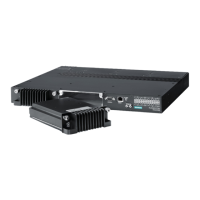RUGGEDCOM RSG2488
User Guide
Chapter 5
Setup and Configuration
Managing Static VLANs 117
Parameter Description
Port(s) Synopsis: Any combination of numbers valid for this parameter
The port number as seen on the front plate silkscreen of the switch.
Type Synopsis: { Edge, Trunk, }
This parameter specifies how the port determines its membership in VLANs. There are
few types of ports:
• Edge - the port is only a member of one VLAN (its native VLAN specified by the PVID
parameter).
• Trunk - the port is automatically a member of all configured VLANs. Frames
transmitted out of the port on all VLANs except the port's native VLAN will be always
tagged.
PVID Synopsis: 1 to 4094
Default: 1
The Port VLAN Identifier specifies the VLAN ID associated with untagged (and 802.1p
priority tagged) frames received on this port.
Frames tagged with a non-zero VLAN ID will always be associated with the VLAN ID
retrieved from the frame tag.
Modify this parameter with care! By default, the switch is programmed to use VLAN 1 for
management and every port on the switch is programmed to use VLAN 1. If you modify
a switch port to use a VLAN other than the management VLAN, devices on that port will
not be able to manage the switch.
PVID Format Synopsis: { Untagged, Tagged }
Default: Untagged
Specifies whether frames transmitted out of the port on its native VLAN (specified by the
PVID parameter) will be tagged or untagged.
4. Click Apply.
Section 5.1.4
Managing Static VLANs
The following sections describe how to configure and manage static VLANs:
• Section 5.1.4.1, “Viewing a List of Static VLANs”
• Section 5.1.4.2, “Adding a Static VLAN”
• Section 5.1.4.3, “Deleting a Static VLAN”
Section 5.1.4.1
Viewing a List of Static VLANs
To view a list of static VLANs, navigate to Virtual LANs > Configure Static VLANs. The Static VLANs table
appears.

